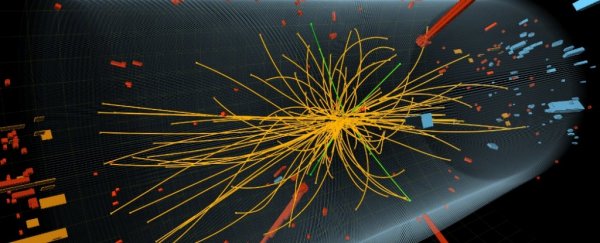If you're a physics fan, you'll be aware that for the better part of 2016, researchers have been flipping out over a mysterious burst of energy detected by the Large Hadron Collider (LHC) at the end of last year.
Journals have been flooded with submissions hoping to explain the excess energy signature, with most speculating that it's evidence of at least one - if not more - fundamental particles that can't be explained by the Standard Model of particle physics. In other words: brand-new, super-exciting physics.
Now CERN has scheduled an update on the finding at the International Conference of High Energy Physics (ICHEP) in Chicago on Friday morning at 9am CST (midnight August 7 AEST).
And for everyone holding out hope of a new particle to sink our teeth into… it's not looking good.
But let's recap for a second. The exciting energy blip, better known as the 750 GeV diphoton excess, was first detected in December as a bump on a data plot in two of the LHC's experiments - CMS and ATLAS.
That means CERN researchers had smashed photons together at incredibly high energies, and in the debris of particles that came tumbling out was an excess in pairs of photons that had a combined energy of 750 gigaelectron volts (GeV).
An unexpected bump on a data plot is exactly how the discovery of the Higgs boson back in 2012 began, and if further collisions support this result, it would be evidence of a new fundamental particle - one that would be six times heavier than the Higgs.
But while the Higgs was predicted by the Standard Model of particle physics - the best set of equations we have for explaining the Universe - this new particle was entirely unexpected, and could represent the first evidence of 'new physics'.
That would be a really, really big deal, because the Standard Model has some big gaps - namely the fact that it doesn't explain gravity - and researchers have spent decades trying to move past it.
Despite the hype, CERN was always very cautious about down-playing these results, explaining that the energy signature could still be a fluke.
And over the past few weeks, rumours have been swirling that the latest round of LHC results have confirmed this is the case, by failing to replicate the 750 GeV excess.
In the lead up to the ICHEP, the CMS team has actually released their results early, revealing this morning that the 750 GeV bump no longer shows up for them once they take into account new data.
That doesn't necessarily mean that ATLAS saw the same thing, but it's not looking good. Physicists on Twitter have already written off the 750 GeV as a "discovery that never was".
That 750 GeV diphoton bump at the LHC that looked like a new particle? It's gone. https://t.co/VfFD272vvG
— John Preskill (@preskill) August 4, 2016
Nothing is confirmed until we hear the full results presented tomorrow by CERN, but it's looking more and more unlikely that we've discovered a new particle.
If you check out the charts above, you can see that, with the new data, that tantalising 'bump' at 750 GeV has flatlined.
But it's all not actually as depressing as it sounds. For starters, there are a whole heap of new discoveries being announced at ICHEP over the weekend (more on those in the coming days - stay tuned).
Secondly, having more evidence to support the Standard Model only strengthens our understanding of physics, and confirms that we're on the right track in our attempts to unravel the Universe.
And thirdly, this is science in action, people! This is what we're here for - new data verifying or disproving earlier observations. It's an honour and a privilege to be able to watch it unfold, so we're never going to get bummed out by the absence of a shiny new discovery, and neither should you.
Top 4 most tragic un-discoveries:
— Katie Mack (@AstroKatie) August 5, 2016
4.Diphoton excess
3.Superluminal neutrinos
2.Mars microbe
1.Primordial grav waves https://t.co/BNRollE6HN
Now, before you get too far into mourning the 750 GeV excess, remember that we still haven't heard the news from CERN as yet.
We'll be updating their announcement as it happens live from 9am August 6 CST (midnight August 6 AEST) so we can all find out the official consensus on the diphoton result together.
Join us to play the CERN drinking game where we take a sip if they announce a new particle, and finish the whole glass if they don't. Shots for every time they show that image of the 750 GeV bump getting flattened out by new data.
Watch this space.
